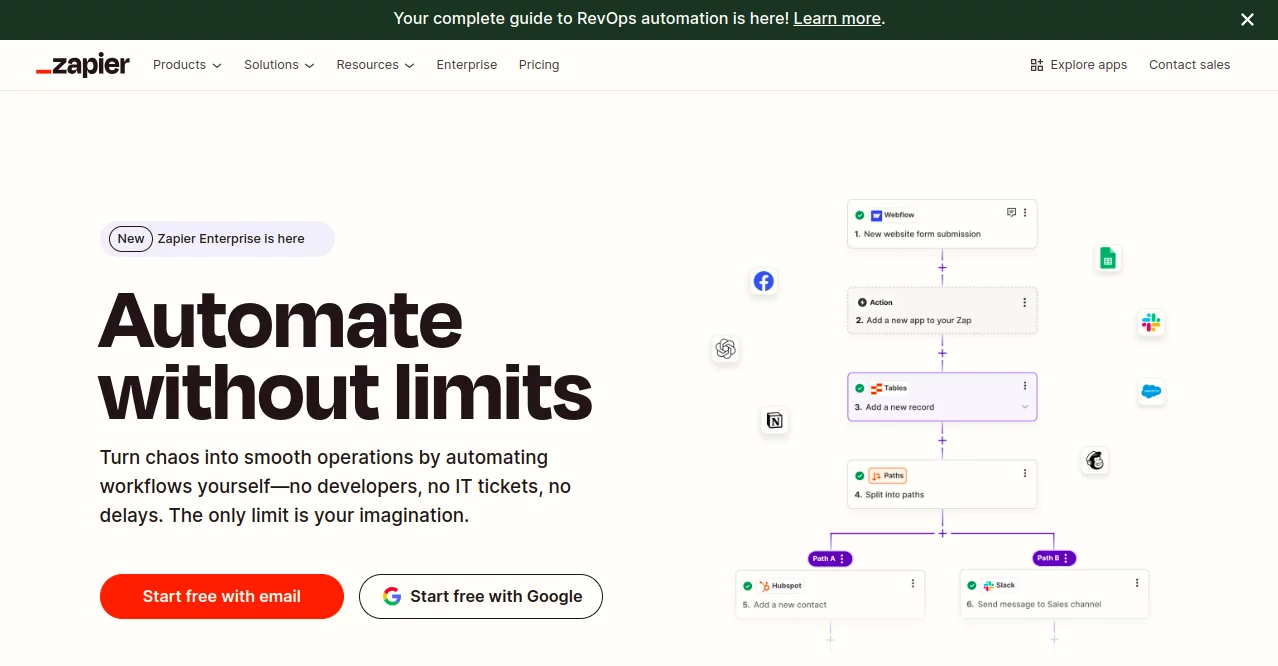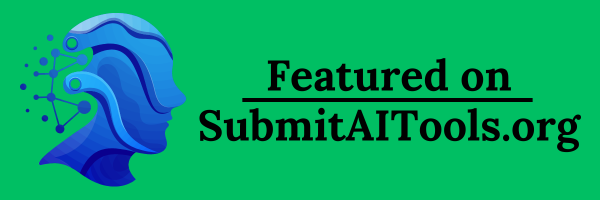🧠 AI Quiz
Think you really understand Artificial Intelligence?
Test yourself and see how well you know the world of AI.
Answer AI-related questions, compete with other users, and prove that
you’re among the best when it comes to AI knowledge.
Reach the top of our leaderboard.
Zapier
Automate Your Workday with Zapier’s Seamless Connections

What is Zapier?
Revolutionizing Workflow Automation for the Modern World
In an era where efficiency and productivity are paramount, businesses and individuals alike are constantly seeking ways to streamline repetitive tasks and focus on what truly matters. This is where Zapier steps in—a powerful, no-code automation platform that connects thousands of apps to create seamless workflows. Since its inception, Zapier has transformed how people work by eliminating manual processes and enabling effortless integration between tools. Whether you’re a small business owner, a marketer, a developer, or an educator, Zapier offers a solution to automate your daily tasks, saving time and boosting productivity. In this article, we’ll explore what Zapier is, how it works, its key features, and why it’s become an indispensable tool for millions worldwide.
The Origins of Zapier
Zapier was founded in 2011 by Wade Foster, Bryan Helmig, and Mike Knoop in Columbia, Missouri. The idea emerged from a simple yet powerful realization: many of the apps people use daily don’t naturally communicate with one another. The founders saw an opportunity to bridge this gap, creating a tool that allows users to connect their favorite applications without needing technical expertise. Initially launched as a side project, Zapier gained traction after being accepted into Y Combinator, a prestigious startup accelerator, in 2012. That same year, the company secured $1.3 million in seed funding led by Bessemer Venture Partners, marking the beginning of its rapid growth.
What sets Zapier apart is its commitment to remote work from day one. Long before remote work became mainstream, Zapier operated as a fully distributed team, a model that has contributed to its unique culture and global reach. Today, Zapier serves over 2.2 million users and supports integrations with more than 7,000 apps, making it a leader in the automation space.
What is Zapier and How Does It Work?
At its core, Zapier is an online automation tool that enables users to create workflows—called “Zaps”—to connect apps and automate tasks. A Zap consists of two main components: a trigger and an action. The trigger is an event in one app that starts the workflow, while the action is the task performed in another app as a result. For example, you could set up a Zap where a new email in Gmail (trigger) automatically creates a task in Trello (action). This simple yet powerful mechanism eliminates the need for manual data entry or switching between tools.
Zapier operates on a no-code platform, meaning you don’t need programming skills to use it. Its intuitive interface allows users to select apps, define triggers and actions, and customize workflows in minutes. With a vast library of supported apps—ranging from Google Sheets and Slack to Salesforce and Shopify—Zapier caters to a wide variety of industries and use cases.
Key Features of Zapier
Zapier’s versatility comes from its robust feature set, designed to simplify automation for users of all levels. Here are some of its standout capabilities:
1. Extensive App Integrations
2. Multi-Step Zaps
3. Filters and Conditional Logic
4. Formatter Tools
5. Schedules and Delays
6. AI-Powered Automation
Zapier connects with over 7,000 apps, covering productivity tools, CRMs, marketing platforms, e-commerce systems, and more. This extensive ecosystem ensures that most tools you already use can be linked effortlessly.
Beyond simple trigger-action workflows, Zapier supports multi-step Zaps, allowing you to chain multiple actions across different apps. For instance, a new form submission could update a spreadsheet, send an email, and post a Slack message—all in one Zap.
Zapier’s filters let you set conditions so that actions only occur when specific criteria are met. This adds precision to your workflows, ensuring they run only when relevant.
The built-in Formatter app helps you manipulate data—like changing text formats, extracting dates, or splitting information—making your automations more tailored to your needs.
Zapier allows you to schedule Zaps to run at specific times or add delays between actions, giving you control over timing and pacing.
Recently, Zapier introduced AI features that let users describe their desired workflow in plain language, and the platform generates a Zap automatically. This innovation further lowers the barrier to entry for non-technical users.
Why Zapier Stands Out
Zapier’s appeal lies in its simplicity and scalability. For small teams or solo entrepreneurs, it offers a free plan with basic automation capabilities, while its paid tiers—starting at $19.99 per month—unlock advanced features like premium app integrations and higher task limits. This flexibility makes it accessible to users with varying budgets and needs.
Another key advantage is Zapier’s focus on saving time. By automating repetitive tasks—like transferring data between apps, sending follow-up emails, or scheduling social media posts—users can reclaim hours each week. For businesses, this translates to cost savings and the ability to focus on strategic goals rather than mundane operations.
Zapier also fosters collaboration. Teams can share Zaps, ensuring consistent workflows across departments. Its remote-first ethos resonates with the modern workforce, particularly as hybrid and distributed teams become the norm. With Zapier, location is no barrier to productivity.
Practical Use Cases
Zapier’s applications are virtually limitless, but here are a few examples of how different groups use it:
Marketers: Automate lead capture by connecting a form tool (e.g., Typeform) to a CRM (e.g., HubSpot) and sending a welcome email via Mailchimp.
E-commerce: Sync new Shopify orders with Google Sheets for inventory tracking and notify your team on Slack.
Educators: Save student submissions from Google Forms to a spreadsheet and send reminders via email.
Developers: Trigger code deployments in GitHub when a task is completed in Asana.
These examples barely scratch the surface. Zapier’s community and blog offer countless templates and ideas to inspire new workflows tailored to your specific goals.
Pricing and Accessibility
Zapier operates on a freemium model. The free plan includes 100 tasks per month and single-step Zaps, making it a great starting point for individuals or small projects. Paid plans, ranging from $19.99 to $69 per month (billed annually), offer more tasks, multi-step Zaps, and access to premium apps like Salesforce and PayPal. Enterprise plans cater to large organizations with custom needs, such as advanced security and team management features.
This tiered structure ensures Zapier remains approachable while scaling with your growth. Plus, its no-code design means anyone can jump in without a steep learning curve.
The Future of Automation with Zapier
As automation becomes integral to work and life, Zapier continues to evolve. Its recent AI enhancements signal a shift toward even smarter, more intuitive workflows. The company’s focus on expanding its app ecosystem and refining user experience positions it as a leader in the no-code movement, empowering people to work smarter, not harder.
In a world where time is a precious commodity, Zapier offers a way to reclaim it. By connecting the tools you love and automating the tasks you don’t, it transforms chaos into order. Whether you’re streamlining a business process or simplifying a personal project, Zapier is the bridge between your apps and your ambitions.
Zapier: video demonstration
These classifications represent its core capabilities and areas of application. For related tools, explore the linked categories above.
Zapier details
Pricing
- Free
Apps
- Web Tools
















